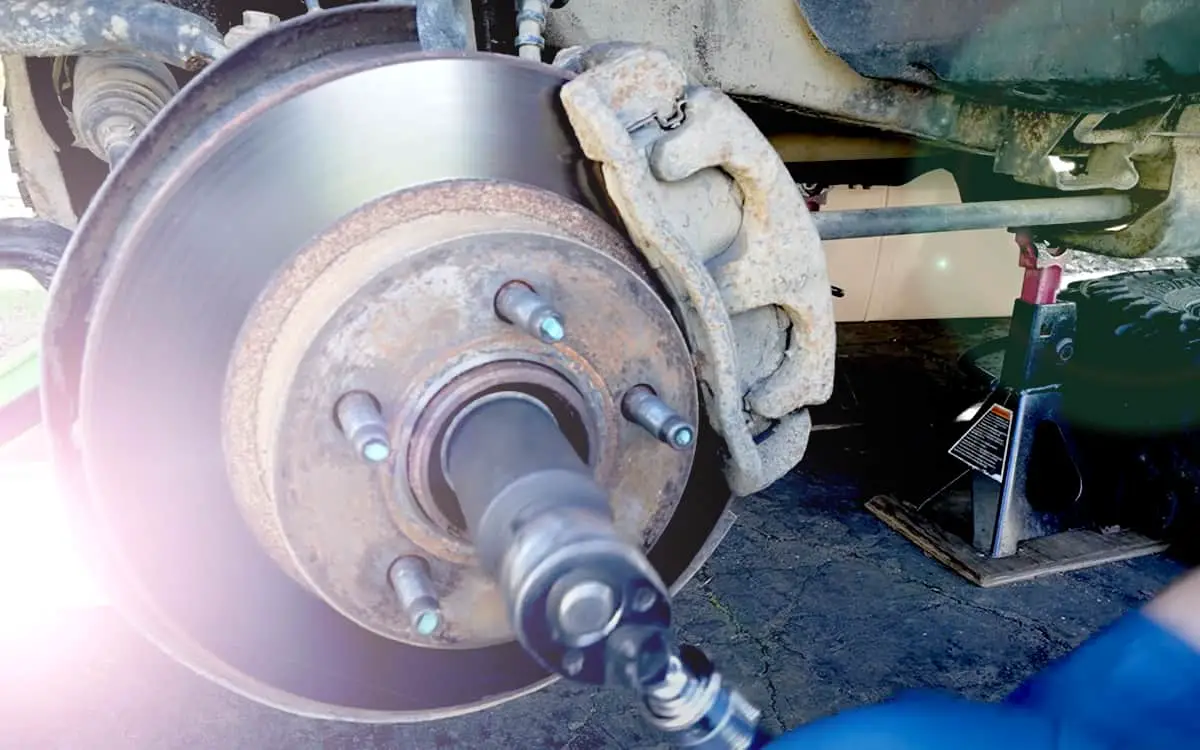Wheel bearings are metal rings that are mounted on the axles of your car. They help to support the weight of the vehicle and allow the wheels to rotate freely. Over time, wheel bearings can become worn out or damaged, which can cause problems with your car’s handling and performance.
Most people confuse wheel bearings to be part of the tire but they are separate parts. If you think that your wheel bearings may be damaged, it is important to have them checked by a qualified mechanic as soon as possible.
How do wheel bearings work?
Wheel bearings allow the wheels to rotate freely and with minimal friction. They are usually made out of steel or other hard metals, and they are lubricated with grease to help reduce friction. When your car is moving, the weight of the vehicle presses down on the wheel bearings, and they help to support the weight of the car and in doing so, they help to keep the wheels in contact with the ground.
If your wheel bearings are damaged, it can cause the wheels to wobble or shake, and it can also cause problems with steering and braking. In extreme cases, it can even lead to the wheels coming off entirely. This is why it is so important to make sure that your wheel bearings are in good condition.
How can you tell if your wheel bearings need to be replaced?
There are a few signs that may indicate that your wheel bearings need to be replaced.
1. Grinding or squealing noises
The first sign you might notice when your wheel bearings need to be replaced is you will notice strange noises coming from your car, such as grinding or squealing. This is caused by the metal-on-metal contact of the damaged bearings. It could be the first sign that tells you that your wheel bearings are damaged and needs replacing.
2. Rough ride
Another sign that your wheel bearings may be damaged is if you feel roughness or vibration in your car when you are driving. This can be caused by the wheels not rotating as smoothly as they should be and can give you an unpleasant driving experience.
3. Steering problems
If your wheel bearings are damaged, it can also cause problems with the steering. You may notice that your car is harder to turn or that the steering feels loose. This is caused by the wheels not being able to rotate freely, which makes it difficult for the car to turn.
4. Play in the wheel
Finally, If you grab the top and bottom of the wheel and move it back and forth, and realize that there is play in the wheel, It’s another sign that your bearings may be damaged.
These are just a few signs that your wheel bearings may be damaged. If you notice any of these problems, it is important to have them checked by
Causes of wheel bearing malfunctions
There are several causes why your wheel bearings malfunction and need to be replaced. These are just some common causes
1. Installation
One of the main causes of why your wheel bearings malfunction is because of poor installation. If your wheel bearings are not installed correctly by your mechanic, it can cause a lot of problems and eventually lead to damage.
2. Worn out parts
Another common cause of wheel bearing damage is simply because they are worn out from use. Over time, the bearings can become damaged from the friction and heat of use, and this can eventually lead to them failing.
3. Misalignment
Another common cause of wheel bearing damage is misalignment. This can happen if your car hits a pothole or curb, This causes the wheel to become misaligned and can damage the bearings.
4. Lack of lubrication
Again, lack of lubrication causes wheel bearing damage. This can happen if you don’t regularly grease your bearings or if you live in an area with a lot of dust and dirt. The lack of lubrication will cause the bearings to wear out faster and eventually fail.
5. Collision damage
Collision is another cause of wheel bearing damage, If you have been in a collision, even a minor one, it can cause the bearings to become damaged. This is because the force of the collision can cause the bearings to become misaligned or to break completely.
6. Unbalanced tires
Unbalanced tires also cause wheel bearing damage. When your tires are unbalanced, it puts extra stress on the bearings and can cause them to fail prematurely.
7. Water damage
Finally, another common cause of wheel bearing damage is water damage. If your car goes through a deep puddle or if you drive in the rain, it can cause water to get into the bearings and cause them to rust. This can eventually lead to the bearings failing.
These are just some of the common causes of wheel bearing damage. If you notice any problems with your bearings, it is important to have them checked by a mechanic as soon as possible.
Preventing Wheel Bearing Damage
Now that you know some of the common causes of wheel bearing damage, here are a few tips to help prevent it.
1. Inspect your bearings regularly
One of the best ways to prevent wheel bearing damage is to inspect them regularly. You can do this by checking for any signs of wear or damage. If you notice anything, it is important to have them checked by a mechanic as soon as possible.
2. Keep your bearings clean and lubricated
Another way to prevent wheel bearing damage is to keep them clean and lubricated. This will help to reduce the amount of friction and heat that they are exposed to.
3. Avoid driving over potholes or curbs
Another way to prevent wheel bearing damage is to avoid driving over potholes or curbs. This can cause the bearings to become misaligned and eventually fail.
4. Balance your tires
Another way to prevent wheel bearing damage is to balance your tires. This will help to reduce the amount of stress that they are under.
5. Drive carefully in the rain
Finally, another way to prevent wheel bearing damage is to drive carefully in the rain. This will help to avoid water getting into the bearings and causing them to rust.
By following these tips, you can help to prevent wheel bearing damage and keep your car running smoothly.
How to replace your wheel bearing
If you have a damaged wheel bearing, it is important to have it replaced as soon as possible. Here are the steps to replace your wheel bearing:
1. Remove the wheel
The first step is to remove the wheel from your car. This will allow you to access the bearings.
2. Remove the old bearings
Next, you will need to remove the old bearings from your car. This can be done with a hammer or a bearing puller.
3. Install the new bearings
Once the old bearings are removed, you can install the new ones. You will need to press them into place using a press or a hammer.
4. Reinstall the wheel
Finally, you can reinstall the wheel on your car. Once it is in place, you can tighten the lug nuts to secure it.
By following these steps, you can replace your wheel bearing and get your car back on the road.
How to temporarily fix wheel bearings?
If you are not able to replace your wheel bearings immediately, there are a few possible temporary fixes that you can use.
1. Grease
One way to temporarily fix damaged wheel bearings is to add more grease to them. This will help to reduce the amount of friction and heat that they are exposed to.
2. Balance your wheels
Another way to temporarily fix damaged wheel bearings is to balance your tires. This will help to reduce the amount of stress that they are under.
3. Drive carefully on rainy days
Finally, As mentioned earlier, Another way to temporarily fix damaged wheel bearings is to drive carefully in the rain. This will help to avoid water getting into the bearings and causing them to rust.
By following these tips, you can help to temporarily fix your damaged wheel bearings and keep your car running smoothly.
However, it is important to note that these are only temporary fixes and you should replace your wheel bearings as soon as possible.
Final thoughts
A wheel bearing is an important component of your car and if not properly maintained, it can lead to serious damage. In this article, we have discussed some of the common causes of wheel bearing damage as well as some tips to prevent it. We have also looked at how to replace your wheel bearing and how to temporarily fix them.
We hope that this article has been helpful and that you now have a better understanding of wheel bearings. If you have any questions or comments, please feel free to send us an email.
Thank you for reading!
Have a great day!

